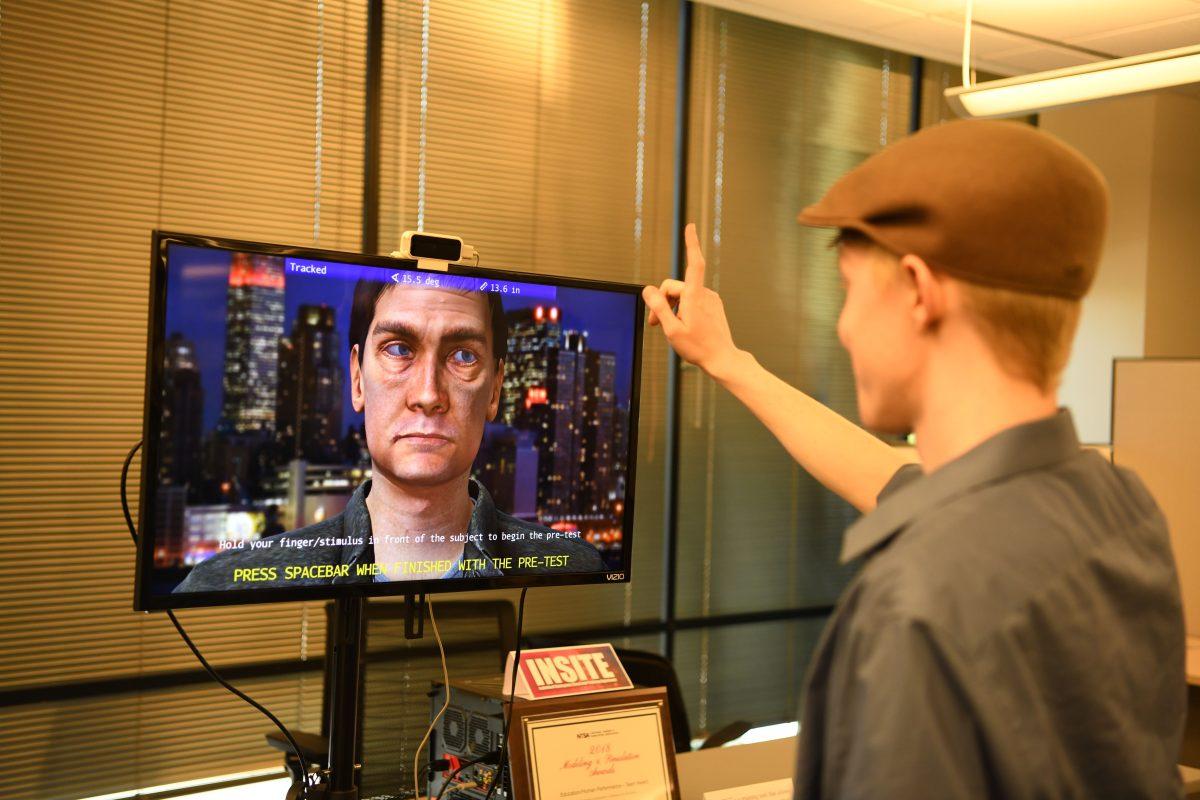
Animated 3D model Brian uses motion-tracking to follow a finger and simulate horizontal gaze nystagmus. The level of twitching in Brian's eyes can help train officers to estimate the level of impairment in drunk drivers. Photo by Aasav Sureja | Mercury Staff.
A UTD
professor partnered with Sam Houston State University researchers and EyeT
Plus, a group of police training experts, to develop software to help law
enforcement spot impaired drivers.
The
Individual Nystagmus Simulated Training Experience project developed by ATEC
professor Marjorie Zielke helps train police officers to identify horizontal
gaze nystagmus, which is the involuntary twitching of an impaired driver’s eyes
when moving side to side in a field sobriety test. How soon the eyes begin to
twitch indicates how impaired the driver is.
“Brian
emulates the way a person’s eyes would move depending on the level of
impairment … We’ve been able to model (the HGN) condition,” Zielke said. “Brian
can emulate other things too, such as medical conditions, eye redness, how wet
your eyes are.”
Brian is
the lifelike simulation of an inebriated adult male. When an officer moves
their finger horizontally in front of a screen topped by a camera, the
simulation uses mathematical algorithms to reproduce the different moving and
twitching in eyes that officers may confront during such HGN tests. Brian also
employs analytical algorithms in order to report on the performance and
technique the officers use.
“Brian
can (also) emulate (medical) conditions because in these cases the police
officer does not need to arrest the person, they need to help them,” Zielke
said.
Occasionally,
there are instances when a person is impaired not because of substance use but
instead for a medical reason, Zielke said. Brian can adapt to emulate other
physiological symptoms. If someone has dissimilar pupil size, that could be an
indicator of a medical condition, such as a stroke.
“(Brian
has) been so well accepted,” Zielke said. “The technology is being used by a
wide range of officers.”
Brian
will be included in Advanced Roadside Impaired Driving Enforcement training
programs throughout Texas, Zielke said, thanks to funding from the Texas
Department of Transportation. As of now, INSITE will be helping train up to 500
officers in 2019, but the team is looking to include the simulation in more
police training programs.
“Right
now, we can only emulate alcohol (impairment), but we’re trying to get
resources to model marijuana,” Zielke said. “I’ve learned from this experiment
that the most common type of impairment is alcohol (with) marijuana.”
There
are seven drug categories that the ARIDE training programs teach officers to
recognize. The INSITE project could model all seven categories, Zielke said,
but it lacks funding and resources.
“We’re hoping that (INSITE) gets totally
integrated into officer training,” Zielke said, “In the way that (Brian)
currently works … there’s no reason that (training programs) can’t be using him
right now.”
Many
different types of law enforcement are using the technology to train their
officers, Zielke said. In May, the research team will conduct a training class
with the Department of Public Safety and integrate INSITE into their training
classes with future state troopers and Highway Patrol.
“It’s been really exciting,” Zielke said.
“There is a lot of potential for all of this.”